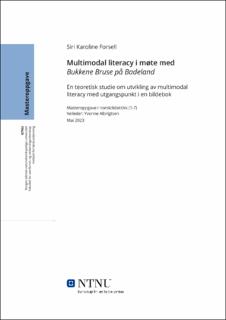| dc.contributor.advisor | Albrigtsen, Yvonne | |
| dc.contributor.author | Forsell, Siri Karoline | |
| dc.date.accessioned | 2023-08-29T17:22:18Z | |
| dc.date.available | 2023-08-29T17:22:18Z | |
| dc.date.issued | 2023 | |
| dc.identifier | no.ntnu:inspera:143756085:34604214 | |
| dc.identifier.uri | https://hdl.handle.net/11250/3086279 | |
| dc.description.abstract | Denne masteroppgaven handler om potensialet bildebøker har utover det å kun lese boka. I studien undersøker jeg hvordan arbeid med én bildebok kan medvirke til at elever tilegner seg kunnskap og ferdigheter som bidrar til utviklingen av multimodal literacy. Bildeboka jeg har valgt å ta utgangspunkt i er Bukkene Bruse på Badeland av Bjørn F. Rørvik og Gry Moursund. Jeg har arbeidet ut fra følgende problemstilling: «På hvilke måter kan bildeboka Bukkene Bruse på Badeland bidra til multimodal literacy hos elever etter 2. trinn?». To forskningsspørsmål som springer ut fra problemstillingen er «Hvordan kan litterære samtaler om bildeboka bidra til kunnskap og forståelse for hvordan ulike modaliteter er med på å skape mening?» og «Hvordan kan skriftlig tekstskaping, med utgangspunkt i en modelltekst, bidra til at elever utvikler kompetanse for hvordan man anvender modaliteter for å skape mening i en tekst?»
Masteroppgaven er todelt. I den første delen utfører jeg en litterær analyse av Bukkene Bruse på Badeland. For å analysere bildeboka har jeg tatt utgangspunkt i teori om multimodalitet, med vekt på hvordan ulike modaliteter skaper mening i bildebøker. Sentralt for analysen er også samspillet mellom modalitetene i teksten, og for å diskutere hvilket samspill som dominerer i den valgte bildeboka tar jeg utgangspunkt i Nikolajeva og Scott (2006) som har utarbeidet fem kategorier om hvordan mening skapes i bildebøker.
I den andre delen drøfter jeg hvordan funnene fra analysedelen kan være et grunnlag for arbeid med Bukkene Bruse på Badeland i praksis. For å belyse problemstillingen, og de tilhørende forskningsspørsmålene, diskuterer jeg på hvilken måte prosessorientert forståelsesopplæring vil kunne bidra til at elever i begynneropplæringen utvikler multimodal literacy. I analysen konkluderer jeg med at bildeboka preges av et samspill der modalitetene utvider hverandre. Videre argumenterer jeg for at det utvidende samspillet mellom modalitetene i bildeboka gir et godt grunnlag for arbeid med bildeboka i både lesefasen og etterlesefasen.
Jeg har funnet ut at klasseromsarbeid med utgangspunkt i Bukkene Bruse på Badeland kan bidra til at elever utvikler flere sentrale elementer innenfor multimodal literacy. Ved å benytte seg av en litterær samtale i lesefasen, og skriftlig tekstskaping i etterlesefasen, får elevene utviklet kunnskap og analytiske ferdigheter som de videre får anvende i eget tekstarbeid. | |
| dc.description.abstract | This master's thesis is about the potential picture books have beyond just reading the book. In the study, I examine how working with one picture book can contribute to pupils acquiring knowledge and skills that contribute to the development of multimodal literacy. The picture book I have chosen to base this study on is Bukkene Bruse på Badeland (The Three Billy Goats Gruff at the Water Park) by Bjørn F. Rørvik and Gry Moursund. I have worked from the following problem: "In what ways can the picture book Bukkene Bruse på Badeland contribute to multimodal literacy in pupils before 2nd grade?" Two research questions that arise from the problem are "How can literary conversations about the picture book contribute to knowledge and understanding of how different modalities contribute to creating meaning?" and "How can written text creation help students develop competence in how to use modalities to create meaning in a text?"
The master's thesis is divided into two parts. In the first part, I carry out a literary analysis of Bukkene Bruse på Badeland. To analyze the picture book, I have started from the theory of multimodality, with an emphasis on how different modalities create meaning in picture books. Central to the analysis is also the interaction between the modalities in the text, and to discuss which interaction dominates in the selected picture book, I take as a starting point Nikolajeva and Scott (2006), who have drawn up five categories on how meaning is created in picture books.
In the second part, I discuss how the findings from the literary analysis can be a basis for how one can use Bukkene Bruse på Badeland in the classroom. To shed light on the issue, and the associated research questions, I discuss in what way dividing the educational work into two phases can contribute to pupils developing multimodal literacy in first and second grade. In the analysis, I conclude that the picture book is characterized by an interaction where the modalities extend each other. Furthermore, I argue that the expanding interaction in the picture book provides a good basis for working with the picture book in both the reading phase, as well as the post-reading phase.
I have found that classroom work based on Bukkene Bruse på Badeland can help students develop several key elements within multimodal literacy. By making use of a literary conversation in the reading phase, and written text creation in the post-reading phase, the students develop knowledge and analytical skills which they can then apply in their own text work. | |
| dc.language | nob | |
| dc.publisher | NTNU | |
| dc.title | Multimodal literacy i møte med Bukkene Bruse på Badeland
En teoretisk studie om utvikling av multimodal literacy med utgangspunkt i en bildebok | |
| dc.type | Master thesis | |
